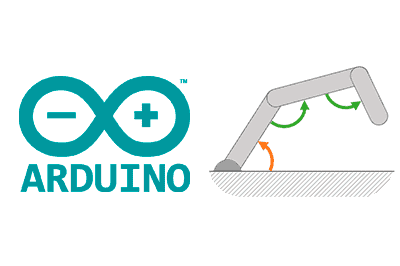In this post we will see the equations necessary to calculate an articulated robot in a processor like Arduino. And in the end, we will see a library so you don’t have to do it ever again!
The resolution of the position and angles of articulated polygons, especially triangles and quadrilaterals, is important because it frequently appears when working with articulated robots, such as robotic arms, quadrupeds, hexapods, bipeds, etc.
In general, in articulated robots we know the distance of each of the sides of the articulated polygon and we act on the motors to change the angle they form between them.
We also know the coordinates of the initial point of the polygon (or we don’t care, if we are going to use relative coordinates to it). On the other hand, each node of the joint has its own coordinates, especially interested in the “end point” because normally it is where we will have the effector (the arm gripper, the robot’s leg, etc).
With this, we have two types of calculations that appear in the resolution of articulated robots:
- Direct, where we know the angles of the joints, and we want to know the position of the effector.
- Inverse, where we know the position of the effector, and we want to calculate the angles necessary to achieve it.
The latter of these two is more common in articulated robots. For example, we know where the ball we want to catch is or where we want to put a leg, and we need to know what angles to set in the motors to achieve it.
The calculation is not particularly complicated, but it requires a small dose of trigonometry. On the other hand, it is worth noting that not all positions will have a solution, while on the contrary some will have more than one (in general, infinite) possible solutions.
Without further ado, let’s see how to solve this problem for the case of articulated triangles and quadrilaterals in 2D, and 3D, the most frequent cases we will have when working with articulated robots.
Articulated 2D Triangle
Direct
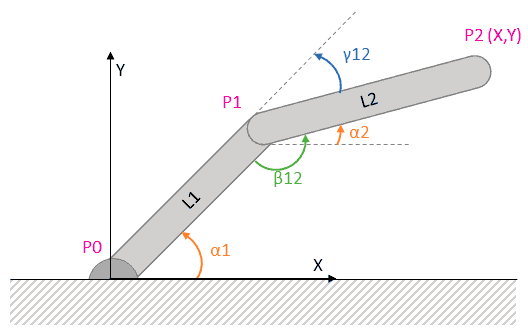
The direct calculation of the position of the effector (P2), based on the absolute angles of the segments, is simply obtained by projecting in X and Y, as follows.
Where the relationship between the relative angles between the segments (both interior and exterior) and the absolute angles of the segments is calculated using the following expressions
Inverse
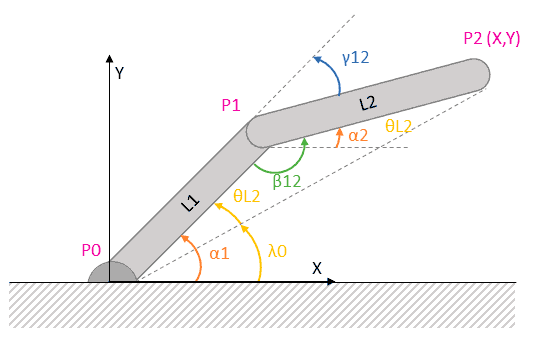
The inverse calculation is equally simple, considering that the two segments form a triangle along with the imaginary line that joins P0 and P2.
We can calculate distance D from the base P0 to P2, applying the Pythagorean theorem.
With this distance and the lengths of the segments, we can calculate all the interior angles of the triangle by applying the generalized cosine theorem.
On the other hand, we can calculate the angle that the triangle forms with the X axis with the following expression.
Finally, we calculate the absolute angle of the first segment by doing.
Knowing the absolute angle of the first segment and the relative angle between them, we can calculate the rest of the relative and absolute angles using the expressions we have seen previously.
Logically, not all positions admit a solution, such as those that exceed the reach of the arms.
Code
This would be a possible example of code to solve an articulated 2D triangle in a processor like Arduino.
float L1, L2, D;
float AbsoluteAngle1, AbsoluteAngle2;
float RelativeAngle12;
float TargetX, TargetY;
float Pythagoras(const float& x, const float& y)
{
const float d = sqrt(x * x + y * y);
return d;
}
float SolveInverseCosine(const float& l1, const float& l2, const float& l3)
{
const float angle3 = acos((l1 * l1 + l2 * l2 - l3 * l3) / (2 * l1 * l2));
return angle3;
}
float AbsoluteToRelative(float absolute1, float absolute2)
{
return absolute2 - absolute1 + PI;
}
float RelativeToAbsolute(float relative12, float absolute1)
{
return absolute1 + relative12 - PI;
}
void SolveTriangle(float& x, float& y, float& l1, float& l2, float& d, float& absoluteAngle1, float& absoluteAngle2, float& relativeAngle12)
{
const float angle_0 = atan2(y, x);
d = Pythagoras(x, y);
const float angle_l1 = SolveInverseCosine(d, l2, l1);
const float angle_l2 = SolveInverseCosine(d, l1, l2);
const float angle_D = PI - angle_l1 - angle_l2;
absoluteAngle1 = angle_0 + angle_l2;
relativeAngle12 = angle_D;
absoluteAngle2 = RelativeToAbsolute(relativeAngle12, absoluteAngle1);
}
void SolveDirect(float angle1, float angle2)
{
AbsoluteAngle1 = angle1;
AbsoluteAngle2 = angle2;
SolveDirect();
}
void SolveDirect()
{
RelativeAngle12 = AbsoluteToRelative(AbsoluteAngle1, AbsoluteAngle2);
TargetX = L1 * cos(AbsoluteAngle1) + L2 * cos(AbsoluteAngle2);
TargetY = L1 * sin(AbsoluteAngle1) + L2 * sin(AbsoluteAngle2);
D = Pythagoras(TargetX, TargetY);
}
void SolveReverse()
{
D = Pythagoras(TargetX, TargetY);
float P2x = TargetX;
float P2y = TargetY;
float D0;
SolveTriangle(P2x, P2y, L1, L2, D0, AbsoluteAngle1, AbsoluteAngle2, RelativeAngle12);
}
void Debug()
{
Serial.print(F("Target X:\t"));
Serial.println(TargetX, 4);
Serial.print(F("Target Y:\t"));
Serial.println(TargetY, 4);
Serial.print(F("Abs. Angle 1:\t"));
Serial.println(degrees(AbsoluteAngle1), 4);
Serial.print(F("Abs. Angle 2:\t"));
Serial.println(degrees(AbsoluteAngle2), 4);
Serial.print(F("Rel. Angle 12:\t"));
Serial.println(degrees(RelativeAngle12), 4);
}
void setup()
{
Serial.begin(115200);
while (!Serial) { ; }
L1 = 100; L2 = 50;
Serial.println(F("Solve Direct Relative"));
SolveDirect(radians(55), radians(-20));
Debug();
Serial.println(F("Solve Inverse"));
TargetX = 104.3423;
TargetY = 64.8141;
SolveReverse();
Debug();
}
void loop()
{
// Do nothing
delay(10000);
}Articulated 2D Quadrilateral
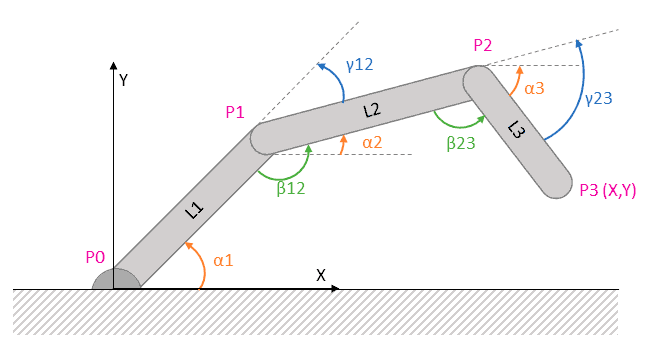
The resolution of an articulated quadrilateral is similar to the articulated triangle, simply projecting the new segment on the X and Y axes.
Inverse
The resolution of an articulated quadrilateral is no more complex than that of the triangle in 2D. The new segment adds an additional degree of freedom, so, in general, the problem admits multiple solutions (infinite).
In order to solve the system, we must impose a condition (or relationship between conditions). It is usual to provide the absolute angle of the last segment, which corresponds to the effector’s angle of attack.
With the coordinates of point P2, we would solve as in the previous case. Like in the case of the triangle, not all positions admit a solution. On the other hand, it is possible that there is a solution only for a certain range of effector angle values.
Often, a relationship is established between the effector’s position and its angle alpha_3, based on the variation of the angle during the robot’s journey being “smooth”.
Code
This would be a possible example of code to solve an articulated 2D quadrilateral in a processor like Arduino.
float L1, L2, L3, D;
float AbsoluteAngle1, AbsoluteAngle2, AbsoluteAngle3;
float RelativeAngle12, RelativeAngle23;
float TargetX, TargetY;
float Pythagoras(const float& x, const float& y)
{
const float d = sqrt(x * x + y * y);
return d;
}
float SolveInverseCosine(const float& l1, const float& l2, const float& l3)
{
const float angle3 = acos((l1 * l1 + l2 * l2 - l3 * l3) / (2 * l1 * l2));
return angle3;
}
float AbsoluteToRelative(float absolute1, float absolute2)
{
return absolute2 - absolute1 + PI;
}
float RelativeToAbsolute(float relative12, float absolute1)
{
return absolute1 + relative12 - PI;
}
void SolveTriangle(float& x, float& y, float& l1, float& l2, float& d, float& absoluteAngle1, float& absoluteAngle2, float& relativeAngle12)
{
const float angle_0 = atan2(y, x);
d = Pythagoras(x, y);
const float angle_l1 = SolveInverseCosine(d, l2, l1);
const float angle_l2 = SolveInverseCosine(d, l1, l2);
const float angle_D = PI - angle_l1 - angle_l2;
absoluteAngle1 = angle_0 + angle_l2;
relativeAngle12 = angle_D;
absoluteAngle2 = RelativeToAbsolute(relativeAngle12, absoluteAngle1);
}
void SolveDirect(float angle1, float angle2, float angle3)
{
AbsoluteAngle1 = angle1;
AbsoluteAngle2 = angle2;
AbsoluteAngle3 = angle3;
SolveDirect();
}
void SolveDirect()
{
RelativeAngle12 = AbsoluteToRelative(AbsoluteAngle1, AbsoluteAngle2);
RelativeAngle23 = AbsoluteToRelative(AbsoluteAngle2, AbsoluteAngle3);
TargetX = L1 * cos(AbsoluteAngle1) + L2 * cos(AbsoluteAngle2) + L3 * cos(AbsoluteAngle3);
TargetY = L1 * sin(AbsoluteAngle1) + L2 * sin(AbsoluteAngle2) + L3 * sin(AbsoluteAngle3);
D = Pythagoras(TargetX, TargetY);
}
void SolveReverse(float absoluteAngle3)
{
AbsoluteAngle3 = absoluteAngle3;
D = Pythagoras(TargetX, TargetY);
float P2x = TargetX - L3 * cos(AbsoluteAngle3);
float P2y = TargetY - L3 * sin(AbsoluteAngle3);
float D0;
SolveTriangle(P2x, P2y, L1, L2, D0, AbsoluteAngle1, AbsoluteAngle2, RelativeAngle12);
}
void Debug()
{
Serial.print(F("Target X:\t"));
Serial.println(TargetX, 4);
Serial.print(F("Target Y:\t"));
Serial.println(TargetY, 4);
Serial.print(F("Target Z:\t"));
Serial.println(TargetZ, 4);
Serial.print(F("Abs. Angle 1:\t"));
Serial.println(degrees(AbsoluteAngle1), 4);
Serial.print(F("Abs. Angle 2:\t"));
Serial.println(degrees(AbsoluteAngle2), 4);
Serial.print(F("Abs. Angle 3:\t"));
Serial.println(degrees(AbsoluteAngle3), 4);
Serial.print(F("Rel. Angle 12:\t"));
Serial.println(degrees(RelativeAngle12), 4);
Serial.print(F("Rel. Angle 23:\t"));
Serial.println(degrees(RelativeAngle23), 4);
}
void setup()
{
Serial.begin(115200);
while (!Serial) { ; }
L1 = 100; L2 = 50; L3 = 30;
Serial.println(F("Solve Direct Relative"));
SolveDirect(radians(55), radians(-20), radians(-70));
Debug();
Serial.println(F("Solve Inverse"));
TargetX = 114.60289;
TargetY = 36.62342;
SolveReverse(radians(-70));
Debug();
}
void loop()
{
// Do nothing
delay(10000);
}Articulated 3D Triangle
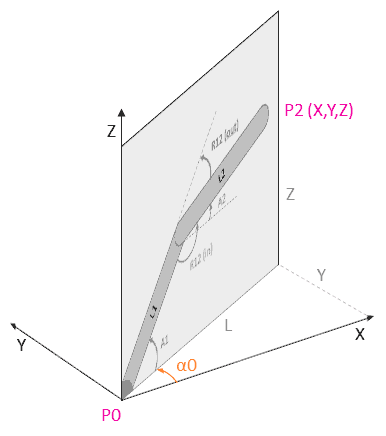
The case of an articulated polygon in 3D can be solved with the same tools as in the 2D case, simply considering that they occur in a plane rotated an angle alpha_0 with respect to the Z-axis.
To convert the coordinates of any point calculated on the plane (Pn’) to their equivalents in 3D (Pn), we use the following relationships.
Where sigma is the angle of rotation between the plane and the X-axis.
Inverse
Similarly, we can convert the inverse calculation of a triangle in 3D to a 2D case by projecting in the equivalent plane.
For this, we will take the 3D coordinates of the effector (P2) to their equivalent in 2D (P2’) using the following relationships.
Finally, we would solve as in the 2D case. The angles between calculated segments are the same as in the 3D case. If we wanted to calculate coordinates of points, we would use the previous relationships to go from 2D to 3D.
Code
This would be a possible example of code to solve an articulated 3D triangle in a processor like Arduino.
float L1, L2, D;
float AbsoluteAngle0, AbsoluteAngle1, AbsoluteAngle2;
float RelativeAngle12;
float TargetX, TargetY, TargetZ;
float Pythagoras(const float& x, const float& y)
{
const float d = sqrt(x * x + y * y);
return d;
}
float Pythagoras(const float& x, const float& y, const float& z)
{
const float d = sqrt(x * x + y * y + z * z);
return d;
}
float SolveInverseCosine(const float& l1, const float& l2, const float& l3)
{
const float angle3 = acos((l1 * l1 + l2 * l2 - l3 * l3) / (2 * l1 * l2));
return angle3;
}
float AbsoluteToRelative(float absolute1, float absolute2)
{
return absolute2 - absolute1 + PI;
}
float RelativeToAbsolute(float relative12, float absolute1)
{
return absolute1 + relative12 - PI;
}
void SolveTriangle(float& x, float& y, float& l1, float& l2, float& d, float& absoluteAngle1, float& absoluteAngle2, float& relativeAngle12)
{
const float angle_0 = atan2(y, x);
d = Pythagoras(x, y);
const float angle_l1 = SolveInverseCosine(d, l2, l1);
const float angle_l2 = SolveInverseCosine(d, l1, l2);
const float angle_D = PI - angle_l1 - angle_l2;
absoluteAngle1 = angle_0 + angle_l2;
relativeAngle12 = angle_D;
absoluteAngle2 = RelativeToAbsolute(relativeAngle12, absoluteAngle1);
}
void SolveDirect(float angle0, float angle1, float angle2)
{
AbsoluteAngle0 = angle0;
AbsoluteAngle1 = angle1;
AbsoluteAngle2 = angle2;
SolveDirect();
}
void SolveDirect()
{
RelativeAngle12 = AbsoluteToRelative(AbsoluteAngle1, AbsoluteAngle2);
float L = L1 * cos(AbsoluteAngle1) + L2 * cos(AbsoluteAngle2);
TargetX = L * cos(AbsoluteAngle0);
TargetY = L * sin(AbsoluteAngle0);
TargetZ = L1 * sin(AbsoluteAngle1) + L2 * sin(AbsoluteAngle2);
D = Pythagoras(TargetX, TargetY, TargetZ);
}
void SolveReverse()
{
AbsoluteAngle0 = atan2(TargetY, TargetX);
D = Pythagoras(TargetX, TargetY, TargetZ);
float Lx = Pythagoras(TargetX, TargetY);
float P2x = Lx;
float P2y = TargetZ;
float D0;
SolveTriangle(P2x, P2y, L1, L2, D0, AbsoluteAngle1, AbsoluteAngle2, RelativeAngle12);
}
void Debug()
{
Serial.print(F("Target X:\t"));
Serial.println(TargetX, 4);
Serial.print(F("Target Y:\t"));
Serial.println(TargetY, 4);
Serial.print(F("Target Z:\t"));
Serial.println(TargetZ, 4);
Serial.print(F("Abs. Angle 0:\t"));
Serial.println(degrees(AbsoluteAngle0), 4);
Serial.print(F("Abs. Angle 1:\t"));
Serial.println(degrees(AbsoluteAngle1), 4);
Serial.print(F("Abs. Angle 2:\t"));
Serial.println(degrees(AbsoluteAngle2), 4);
Serial.print(F("Rel. Angle 12:\t"));
Serial.println(degrees(RelativeAngle12), 4);
}
void setup()
{
Serial.begin(115200);
while (!Serial) { ; }
L1 = 100; L2 = 50;
Serial.println(F("Solve Direct Relative"));
SolveDirect(radians(30), radians(55), radians(-20));
Debug();
Serial.println(F("Solve Inverse"));
TargetX = 90.3631;
TargetY = 52.1711;
TargetZ = 64.8142;
SolveReverse();
Debug();
}
void loop()
{
// Do nothing
delay(10000);
}Cuadrilátero articulado 3D
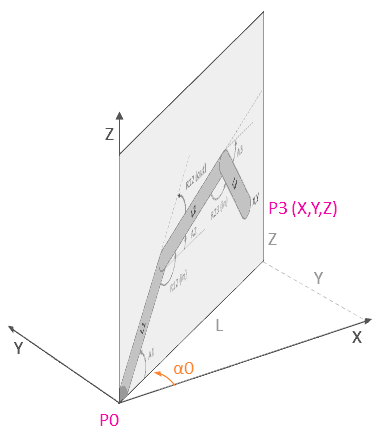
Forward
Similarly, for the direct calculation of an articulated quadrilateral in 3D, we project onto a 2D plane using the expressions from the previous section, only considering that this time the angle alpha_0 is.
Inverse
Similarly, an articulated quadrilateral can be solved using the same tools as its 2D equivalent. The only difference is that, in this case, the coordinates of the effects in the equivalent 2D case (P3’) are calculated from the 3D point (P3) according to the following relat
Code
This could be a possible example of code to solve an articulated quadrilateral in 3D on a processor like Arduino.
float L1, L2, L3, D;
float AbsoluteAngle0, AbsoluteAngle1, AbsoluteAngle2, AbsoluteAngle3;
float RelativeAngle12, RelativeAngle23;
float TargetX, TargetY, TargetZ;
float Pythagoras(const float& x, const float& y)
{
const float d = sqrt(x * x + y * y);
return d;
}
float Pythagoras(const float& x, const float& y, const float& z)
{
const float d = sqrt(x * x + y * y + z * z);
return d;
}
float SolveInverseCosine(const float& l1, const float& l2, const float& l3)
{
const float angle3 = acos((l1 * l1 + l2 * l2 - l3 * l3) / (2 * l1 * l2));
return angle3;
}
float AbsoluteToRelative(float absolute1, float absolute2)
{
return absolute2 - absolute1 + PI;
}
float RelativeToAbsolute(float relative12, float absolute1)
{
return absolute1 + relative12 - PI;
}
void SolveTriangle(float& x, float& y, float& l1, float& l2, float& d, float& absoluteAngle1, float& absoluteAngle2, float& relativeAngle12)
{
const float angle_0 = atan2(y, x);
d = Pythagoras(x, y);
const float angle_l1 = SolveInverseCosine(d, l2, l1);
const float angle_l2 = SolveInverseCosine(d, l1, l2);
const float angle_D = PI - angle_l1 - angle_l2;
absoluteAngle1 = angle_0 + angle_l2;
relativeAngle12 = angle_D;
absoluteAngle2 = RelativeToAbsolute(relativeAngle12, absoluteAngle1);
}
void SolveDirect(float angle0, float angle1, float angle2, float angle3)
{
AbsoluteAngle0 = angle0;
AbsoluteAngle1 = angle1;
AbsoluteAngle2 = angle2;
AbsoluteAngle3 = angle3;
SolveDirect();
}
void SolveDirect()
{
RelativeAngle12 = AbsoluteToRelative(AbsoluteAngle1, AbsoluteAngle2);
RelativeAngle23 = AbsoluteToRelative(AbsoluteAngle2, AbsoluteAngle3);
float L = L1 * cos(AbsoluteAngle1) + L2 * cos(AbsoluteAngle2) + L3 * cos(AbsoluteAngle3);
TargetX = L * cos(AbsoluteAngle0);
TargetY = L * sin(AbsoluteAngle0);
TargetZ = L1 * sin(AbsoluteAngle1) + L2 * sin(AbsoluteAngle2) + L3 * sin(AbsoluteAngle3);
D = Pythagoras(TargetX, TargetY, TargetZ);
}
void SolveReverse(float absoluteAngle3)
{
AbsoluteAngle3 = absoluteAngle3;
AbsoluteAngle0 = atan2(TargetY, TargetX);
D = Pythagoras(TargetX, TargetY, TargetZ);
float Lx = Pythagoras(TargetX, TargetY);
float P2x = Lx - L3 * cos(AbsoluteAngle3);
float P2y = TargetZ - L3 * sin(AbsoluteAngle3);
float D0;
SolveTriangle(P2x, P2y, L1, L2, D0, AbsoluteAngle1, AbsoluteAngle2, RelativeAngle12);
RelativeAngle23 = AbsoluteToRelative(AbsoluteAngle2, AbsoluteAngle3);
}
void Debug()
{
Serial.print(F("Target X:\t"));
Serial.println(TargetX, 4);
Serial.print(F("Target Y:\t"));
Serial.println(TargetY, 4);
Serial.print(F("Target Z:\t"));
Serial.println(TargetZ, 4);
Serial.print(F("Abs. Angle 0:\t"));
Serial.println(degrees(AbsoluteAngle0), 4);
Serial.print(F("Abs. Angle 1:\t"));
Serial.println(degrees(AbsoluteAngle1), 4);
Serial.print(F("Abs. Angle 2:\t"));
Serial.println(degrees(AbsoluteAngle2), 4);
Serial.print(F("Abs. Angle 3:\t"));
Serial.println(degrees(AbsoluteAngle3), 4);
Serial.print(F("Rel. Angle 12:\t"));
Serial.println(degrees(RelativeAngle12), 4);
Serial.print(F("Rel. Angle 23:\t"));
Serial.println(degrees(RelativeAngle23), 4);
}
void setup()
{
Serial.begin(115200);
while (!Serial) { ; }
L1 = 100; L2 = 50; L3 = 30;
Serial.println(F("Solve Direct Relative"));
SolveDirect(radians(30), radians(55), radians(-20), radians(-70));
Debug();
Serial.println(F("Solve Inverse"));
TargetX = 99.2490;
TargetY = 57.3014;
TargetZ = 36.62342;
SolveReverse(radians(-70));
Debug();
}
void loop()
{
// Do nothing
delay(10000);
}Arduino Articulated Library
What if we package this into a library to make it more convenient to use? Absolutely! Here’s an Arduino Articulated library that performs all the aforementioned calculations conveniently and easily. Enjoy
